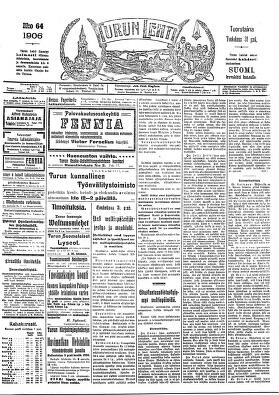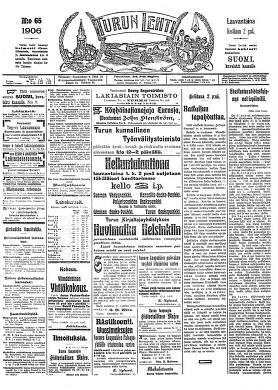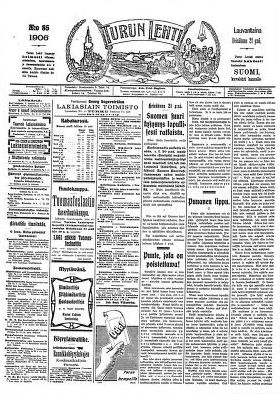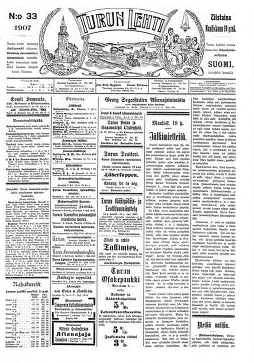Tiina Hölttä, planning officer at the National Library of Finland, looks at how newspapers reported various voting and parliamentary reforms in 1906, including women’s right to vote and run for parliament.
First, some historical facts relating to the chain of events that led to women winning voting rights in Finland. In the years before this right was granted, Finland was an autonomous Grand Duchy in the Russian Empire (this lasted from 1809 to 1917). The Diet of Finland was the legislative body in the Grand Duchy of Finland and it met regularly between 1863–1906. Until 1906 there were four estates (the nobility, clergy, the burghers and peasantry) represented. An extra Diet was convened in 1906.
Fact #1. A new Parliament Act and a State Electoral Law was approved on the 29th of May in 1906 to replace the Assembly of the representatives of the estates with a Parliament.
Fact #2.Russian Tsar Nicholas II confirmed on July 20th 1906 the new electoral law of Finland called “the Parliament Act of the Grand Duchy of Finland”. It guaranteed a universal and equal unrestricted right to vote. Finnish women were the first in Europe to be given the right to vote, and third in the world after New Zealand and South Australia. At the same time, they were first in the world to be granted the right to stand for parliament.
Fact #3. The new Finnish parliamentary system and the electoral law reforms came into effect on the 1st of October 1906 and the first parliamentary elections were held on 15th and 16th of March 1907. Nineteen women were elected to a parliament of 200, which was a surprise. They represented various professional groups, including teachers, factory workers, farmers’ wives and high school graduates.
Fact #4. The new members of parliament convened in their first plenary session on 23rd May 1907.
This article focuses on the historic newspaper Turun Lehti (explore this paper on Europeana and on The European Library), published from 1882–1919. In the early years, it was published twice a week and, from 1884, three times a week. The newspaper was founded to compete with other Finnish language newspapers, called Aura and Sanomia Turusta in the Turku area.
When the structure of the Finnish parliament was revealed, Turun Lehti announced its intention to exercise moderation and impartiality, even though it had a clear admiration of all things Swedish. It was nearly silent on the question of the Finnish and Swedish languages and their official status, whereas the Aura newspaper took a clear stand on the question of language.
Instead of language, Turun Lehti promised to write on financial issues, particularly those related to agriculture. Most of the news was local, but to some extent it also included international news, as well as plenty of literary material and drawing illustrations. The principle of ‘something for everyone’ made it popular among the people. Turun Lehti spread widely over the south-western borders of Finland. Its circulation in 1905 was 10,600 – a considerable amount at that time for a newspaper.
Within the pages of Turun Lehti, we can find articles that relate directly to the chain of historical events presented at the beginning of this article.
The Approval of a new Parliament Act and a State Electoral Law (May 29th 1906)

Turun Lehti ran two articles on this topic in its issue of 31st May 1906. Both were published on the front page. The first headline “Uusi waltiopäiwäjärjestys ja waalilaki” (in English The new parliament act and the state electoral law) only dealt with the estates handled by the electoral law reform; women’s right to vote was not specially mentioned. The second headline was “Eduskuntauudistuskysymys waltiopäiwillä” (in English The parliamentary reform in the Diet). This article concerned, for example, the intention to raise the voting age limit from 21 years to 24 years, as well as the other discussions concerning the reform. This was an extra-long multi-column article, which continued in the next issue.

On the 2nd of June 1906, the newspaper continued with its series and published another headline on the frontpage: “Ratkaisun tapahduttua” (in English “The Solution is made”).
The article refers to the news taken from Finland’s largest newspaper Helsingin Sanomat. The article explains the significant historic reform: vote expansion from 200,000–300,000 voters to 1,400,000 entitled voters, when all men and women are allowed to vote.
Russian Tsar Nicholas II confirms the new electoral law of Finland on July 20th 1906

On the front page of Turun Lehti on the 21st of July 1906 there was a headline “Suomen suuri kysymys lopullisesti ratkaistu” (in English “The big question of Finland is finally resolved”). The article only concerned the new Parliament Act and the electoral law. It did not include any specific mention of women’s suffrage.
The Finnish new parliamentary system and the electoral law reforms came into effect on the 1st of October 1906
Turun Lehti did not publish any articles of these reforms coming into force. Other newspapers published articles on this topic.
The first parliamentary elections of Finland were held on the 15th and 16th of March 1907

On the 14th of March 1907, the day before the historic elections, Turun Lehti ran an article highlighting this historic event: where the Finnish people, rich and poor, those of noble and humble birth, had an equally legitimate right to perform the duties of a responsible citizen. It described this “wonderful vote” as the citizens waking up from years of repression, as a result of centuries of slumber.
Turun Lehti published one article after elections on the 19th of March 1907 with the front page headline “Jälkimietteitä” (in English “After-thoughts”). The article criticized the behaviour of the various parties during the election campaign, but did not mention the women’s right to vote at all.
The new members of parliament, among them 19 women, convened at parliament in their first plenary session on 23rd May 1907.
On it’s front page, Turun Lehti published the news with the headline “Waltiopäiwät” (in English “The plenary session of the parliament”). In the article, they wrote:
“Yesterday was the anniversary of the most recent Finnish history. For the afore mentioned: date, the 22nd of May in 1907, convened the new, now under the Parliament Act and existing by universal and equal suffrage, elected parliament for the first time in the plenary session of the parliament in Finland. … For the first time, there are now 200 representatives gathered to concern and resolve important issues for the country and its citizens, who were selected for this important task, when the universal and equal right to vote for the first time in this country – the first in the whole of Europe – was used. … In these elections, women are just as entitled to vote than men, and those women elected as parliament members at first time have now convened to the plenary session of the parliament. Finland is in comparison with the governmental right to vote the leading country in Europe, and that is why the whole Europe wants to check how the parliament, which is elected by universal and equal suffrage, performs its tasks.”
Did the articles report the events as we know them from history books? Surprisingly, there were many minor differences in dates. Some sources mention the official history of the event that it took place a day or days later, even though the newspapers had already reported on the topics.
Do the articles display any political view of the time? The articles clearly mirrored the spirit of the past times on the whole. The women’s movement for equal rights was buried under other major turning points of the society. The question of the voting rights for women did not get as much exposure as it might have in a different phase of history.
Finland was in the years 1906–1907 in the middle of the Russian political “thaw”. Russia had suffered a defeat in the war on Japan and the opposite clout and revolutionary movement forced Nicholas II to make concessions. In these circumstances, the right to vote reform was a surprise to Finland in 1906.
References:
- Centre for Parliamentary Studies. University of Turku.
- Suomen sanomalehdistön historia 7. 1988. Hakuteos Savonlinna – Övermarks Tidning: Sanoma- ja paikallislehdistö 1771–1985. Tommila P. (ed.); Ekman-Salokangas, U., Aalto, E-L, Salokangas, R. Kuopio: Kustannuskiila.
- Wikipedia 1906, 1907 and the history of the right to vote.
- The National Library of Finland. Historical newspaper library.

The article is most interesting. How come the Finnish parliament got only one chamber? Where all the previous four estates/groups ready to accept a one chamber parliament solution, or was some of them against it? Was the decision to have only one chamber in the parliament made by officials/ bureaucrats, by politicians or by the media/the general opinion? The Russian Duma, launched in the same time,was divided into two chambers. Did the tsar have the same rights to regulate the decisions made by the Duma as he had in relation to the Finnish parliament?
Gustav Wickström
gustav.wickstrom@gmail.com
I happened today, 13th of Jan 2018, to read the article as well as my comment once more and may be able to answer the question I put myself. Due to the Rujssian governements striving to undo the autonomy of Finland, officially launched by the tsar Nikolaj II in the beginning of 1898, it was considered important to rally all Finns behind the struggle to stop the Russification. After to Russian-Japanese war in 1904-05, which the Russians lost, there was launched a general strike, the first ever, first in Russia and after that also in Finland. The workers movement had shown it´s strength and it was important for the bourgoise (?) parties to have everybody aboard, when demanding reform of the voting system. The socialdemocrats demanded not only voting rights for both men and women, but also- as I understand – the abolition of the different chambers. To please the, Leo Mechelin and other leading right-wing politicians, agreed to demand a one-chamber “parliament”. As ut`s decision anyway had to be approved by the Russian goverment, Nicholaus II accepted this. When he was ousted in the beginning of 1917 the Finnish parliament happened for the first time to have a left-wing majority. Due to the many progressive laws it accepted, it was dissolved by the interim Russian government. In the new election that followed, the right wing won back the majority of seats.
Pingback: A ascensão das mulheres na política finlandesa - BrasileirasPeloMundo.com
Pingback: III-Companies in the Balkans(1902-1918) | ISSD